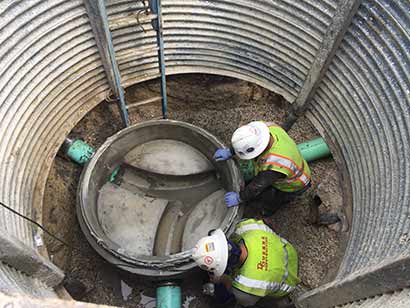Frustrated rush-hour drivers ask themselves the same question as they crawl along the highway: what’s so hard about widening a road? Can’t someone just plan it, throw more roadway on the ground, and call it done?
Actually, no. When you’ve asked that question, stuck in traffic, you probably already knew the answer. But even if it were that easy, there’s something else to consider: utilities. Major roadways often have utility lines located within the road’s right of way (ROW). When the road’s edge of pavement gets extended, so must electrical and gas lines, water and wastewater conduits, telecommunications cables, and more.
Road widening can entail complex coordination. Engineers work with the road’s jurisdictional owner (TxDOT, county, or municipality, for example) to assess the general project scope of the road improvements. They also engage adjacent property owners about terms for the government’s acquisition of new ROW (the area of adjacent lawns or parking lots to be absorbed by the roadway improvements).
According to Senior Project Manager Deepa Elter, P.E., CFM, LGPP, of Pape-Dawson Engineers, conversations with affected utilities start early in the process. As the project manager responsible for relocating utilities on San Antonio’s 26-mile north-side expansion of Loop 1604, her charge includes deconflicting the utility issues that inevitably arise. “Well before TxDOT owns the property, we start engaging with all affected utility companies,” she says. “For this project, we’ve been in discussions for nearly a year.”
“We start with TxDOT guidelines regarding the depth of certain utilities,” says Deepa, but plenty of conflicts still arise. In only one of her Loop 1604 project’s five segments, her team identified more than 500 utility conflicts. Deepa’s task is to facilitate discussions to solve them, asking participants hard questions about each. How can we resolve the conflict? Can we design around it? Does the utility need to move?
Keeping the project on path means a utility engineer makes day-by-day, incremental progress. “I meet weekly with TxDOT, all 18 utility companies, and the design team,” she says. The design team, she adds, comprises engineers from Pape-Dawson and nearly a dozen other firms. Between meetings, emails shuttle back and forth to keep forward momentum.
Sometimes these utility coordination meetings are conducted one-on-one, and sometimes Deepa will facilitate a joint utility coordination meeting, where multiple utilities participate to resolve conflicts together. She then brings the results of these sessions back to the engineers for them to work through. Deepa leads this process with her goal always in mind: “a clear-cut resolution that’s a good fit for the project, one everyone’s happy with.”
As utility conflicts are identified, each one gets added to a GIS-informed database. Deepa’s Loop 1604 project will likely log thousands of issues, and each one will require careful resolution involving multiple stakeholders. In both design and execution, phasing is paramount. Often, utilities must be moved one at a time before roadway construction can begin. Carefully sequencing that operation upfront can avoid delays down the road (ahem…).
Francisco “Paco” Guerrero, P.E., Water Resources Practice Leader for Pape-Dawson, has a similar challenge in Austin, where TxDOT looks to substantially widen IH 35 in the city’s downtown area. Before that can happen, however, utilities need to be considered. “I’m currently working on behalf of the City of Austin for Austin Water,” Paco says, “to identify conflicts in all lines that will be affected by this massive roadway project.” His more focused purview is on finding conflicts with water, wastewater, and reclaimed water lines on the eight-mile stretch. Austin Water wants to understand the roadway construction’s implications for existing utilities, evaluate necessary system improvements, and perhaps get a head start on some solutions. In fact, Paco’s work will take him beyond coordination and into actual design – from schematics up to 30%.
Although he began in earnest only a few months ago, Paco predicts a significant undertaking. “It takes time to evaluate all these impacts because there are multiple ramifications. If you cut this line, what happens downstream or upstream? It’s like a network that’s connected, and if you cut at one place, you don’t know what’s going to happen elsewhere unless you understand how the overall water system operates.”
Key to understanding the details is breaking the project into chunks, says Paco. “These are such huge projects that just looking at them makes some people want to crawl under the covers,” he admits with a smile. “You have to break it up into smaller tasks, give team members individual assignments, and then follow up.” He continues: “That’s the kind of thing you have to do to keep the project on track, on schedule, and on budget.”
Deepa agrees, and adds another key to success: “Document everything.” With so many details, confusion can creep in without lock-tight, shared methods of tracking. Keeping a geolocated database current with the status of each issue and resolution details ensures nothing gets forgotten.
Most of the work utility engineers do go unnoticed because utilities are installed underground, but it is an essential component of any road improvement project and has a direct impact on our daily lives. With utility engineers working behind the scenes, road construction can continue. And when weary drivers get home at the end of the day, their lights, toilets, ovens, and internet still work.
